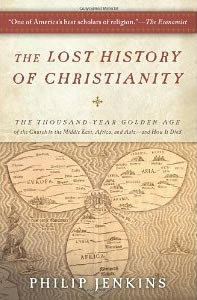[The above is mostly a
reading of the text below, with an occasional aside thrown in for good measure,
as they strike me as relevant. I welcome
questions, comments, or concerns about the material contained in this video.]
To speak of Christianity is almost necessarily to turn our imaginations toward Western Europe, where Christianity flourished for centuries in the midst of religious wars, social turmoil, and even Islamic competition for economic and military power. However, the “thousand-year Golden Age” referred to in the subtitle of Philip Jenkins’ book refers not to the West, but the various Christianities that arose all over northern Africa, the Levant, the Middle East, and the far East. Instead of the Latin that dominated the West, Christianity in the rest of the world was conducted in a number of languages, including Syriac and the Koine Greek of Saint Paul. While Jenkins looks at Christianity in various parts of the East, he largely clumps them together as “Syriac-Nestorian,” referring to the language and Nestorianism, a brand of Christian theology long considered a heresy in the West but that held on in the East.
Jenkins spends most of his time talking about Christianity in different parts of the Eastern world, instead of, as the subtitle hints, telling us “how it died.” This is much more a book, in fact, of how these communities flourished and lived side-by-side with people of other religions. We get vignettes of how, in the East, Christians lived next to Jews and especially Muslims for centuries. Around the thirteenth or fourteenth century, however, Muslims – who almost always were the power-holding elites in these regions – began to grow increasingly intolerant toward religious minorities. Why? Jenkins never really says. He offers a number of explanations, which I believe were meant to be the heart of the book, including the marginalization of certain languages, and the rise of a powerful, political Islam, but he never makes it seem like he is convinced of any of them.
I found this to be a confusing, or rather confused, book that wasn’t aware of what it wanted to say. It would have been much better with a different (sub)title, and a thesis – any thesis. Instead, the reader gets a mishmash that tries to convey the importance of Christianity in the East and to some extent succeeds. But if you want an explanation of why Christianity survived in the West, but was nearly totally decimated in the East, you won’t find much of an explanation here. I might suggest this to someone for whom the Christian East is a wholly new concept, but there are sure to be better resources out there than what this book has to offer.

No comments:
Post a Comment